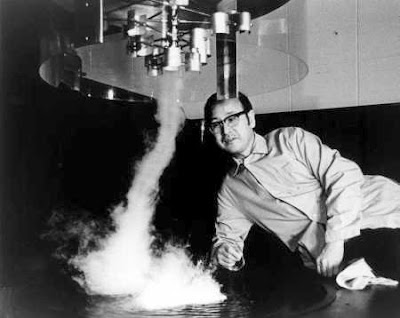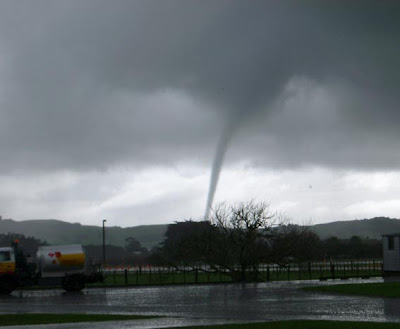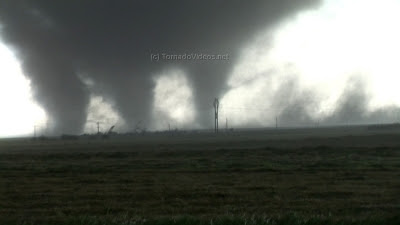Pre-post: This is my 400th post!
F5 by Mark Levine chronicles the "Super Tornado Outbreak" of April 3, 1974. The whole title is F5: Devastation, Survival, and the Most Violent Tornado Outbreak of the Twentieth Century.
 The "F" in the book's title commemorates Dr. Ted Fujita, "Mr. Tornado," who ranked tornadoes in six classes, F0 to F5. He is shown here at the University of Chicago, where he spent nearly fifty years, with a tornado simulation machine. He passed away nine years ago.
The "F" in the book's title commemorates Dr. Ted Fujita, "Mr. Tornado," who ranked tornadoes in six classes, F0 to F5. He is shown here at the University of Chicago, where he spent nearly fifty years, with a tornado simulation machine. He passed away nine years ago.The 1974 super outbreak included tornadoes of all strengths, and six that were ranked F5. According to a modern revision of the scale, a "EF5" tornado has winds exceeding 200 mph (322 kph or 89 m/s). Fujita's original F5 ranking meant winds exceeding 260 mph (418 kph or 116 m/s). The modern revision was driven by the feeling (prejudice?) of many meteorologists that winds at ground level just don't get as high as Dr F believed...and he isn't here to defend himself.
Dr. Fujita surmised a rank of F6, with winds exceeding 318 mph (512 kph or 142 m/s). Since an F5 leaves little behind it but plowed ground, there is little likelihood that we could determine after the fact whether an F6 actually was present. All the wind speed estimates are based on damage to structures and trees, so there is a lot of possible variation.
 This is Dr. Fujita's map of the outbreak, showing the ground tracks of all 148 tornadoes that struck that day. Detailed information, and this map, can be found at the April 3 1974 web site.
This is Dr. Fujita's map of the outbreak, showing the ground tracks of all 148 tornadoes that struck that day. Detailed information, and this map, can be found at the April 3 1974 web site.As a general pattern, the outbreak began to the northwest and moved to the southeast, and tornadoes tended to occur in groups that followed one another in a northeasterly direction. I saw such behavior twice, on much less desparate occasions, once in Ohio and once in Kansas.
On the latter occasion the storm itself, a large thunderstorm, was moving slowly northeast. It had a wall cloud and mesocyclone on its southeast side. A funnel would descend near the back edge of the wall cloud, move toward the front in a northeasterly direction, then lift. Sometimes the next funnel would appear while the first was on the ground. I saw five (fortunately F0 or F1) tornadoes in a half hour, from that storm. As that storm dissipated, another one formed to its south, but fortunately didn't grow nearly as strong, and spawned no funnels.
 In F5 Mr. Levine focuses on two tornadoes called Tanner #1 and Tanner #2, numbers 96 and 97 in this clip from the larger map. They both swept through Limestone County, Alabama just after sunset. One mostly demolished Lawson's Trailer Park, the other crushed most of what the first had missed.
In F5 Mr. Levine focuses on two tornadoes called Tanner #1 and Tanner #2, numbers 96 and 97 in this clip from the larger map. They both swept through Limestone County, Alabama just after sunset. One mostly demolished Lawson's Trailer Park, the other crushed most of what the first had missed.Tanner #1 was an F5, the other an F4, with winds only about 30 mph slower (48 kph or 13 m/s). Both made ground tracks about a third of a mile wide. The width of a tornado "on the ground" only roughly correlates with its strength. There are F0 tornadoes that get a mile wide, and F5 tornadoes that were no more than a quarter mile wide.
The widest ground track on record is 2.5 miles (4 km) for the F4 Hallam, NE tornado of May 22, 2004. However, radar measurements of the May 3, 1999 tornado at Mulhall, OK, also an F4, indicate damaging winds extended over a diameter of 4.4 miles (7 km), and the "hot circle", 1 mile (1.6 km) in diameter, had wind speeds exceeding 245 mph (400 kph or 110 m/s); that's EF5 by the new scale, F4 by the old one.
 An F0 tornado like this one, and the F1 shown next, are more typically narrow at the ground, from 50 to a couple hundred feet wide (15-50m). Most of the tornadoes in the 1974 outbreak were in this range. Of recorded tornadoes in the Twentieth Century, 75% have been F0 and F1. However, F4 and F5, which comprise 5% of the total, account for 65% or more of tornado deaths.
An F0 tornado like this one, and the F1 shown next, are more typically narrow at the ground, from 50 to a couple hundred feet wide (15-50m). Most of the tornadoes in the 1974 outbreak were in this range. Of recorded tornadoes in the Twentieth Century, 75% have been F0 and F1. However, F4 and F5, which comprise 5% of the total, account for 65% or more of tornado deaths.When we lived in Oklahoma, there was a saying to back up the admonition to get out of your car when tornadoes were about: "When the tornado is done with your car, there won't be room inside for you." Having seen a car planted next to the road I took to work each day, well munged by an F1 tornado, I can well believe it.
 An F1 tornado is an awesome beast. I can't imagine what it is like being close to an F4 or F5, but that is what happened to several dozen people who lived in the Athens-Decatur area of northern Alabama. Author Levine focuses on Limestone County, and on 25 residents who met Tanner #1 and/or #2, personally. Some didn't live through it.
An F1 tornado is an awesome beast. I can't imagine what it is like being close to an F4 or F5, but that is what happened to several dozen people who lived in the Athens-Decatur area of northern Alabama. Author Levine focuses on Limestone County, and on 25 residents who met Tanner #1 and/or #2, personally. Some didn't live through it.Throughout the book, he presents vignettes from the experiences and memories of a young couple, high schoolers at the time, who married shortly after recovering from their injuries. Donnie and Felicia (neé Golden) Powers tried to get out of their car when the F5 roared up, but the wind at first held the car door shut. Then it ripped it off, blasted them both with debris, and blew then right out of the car. They were comparatively lucky. Some folks got out of their car and fled to a ditch. The tornado dropped the car on top of them.
 By daylight, an F3 tornado like this is scary enough. In the dark just after sunset, the big F5 seemed to pop up right in front of Donnie and Felicia. Once a tornado has been on the ground more than a few seconds, it fills with dirt, and may also be wrapped in rain or hail.
By daylight, an F3 tornado like this is scary enough. In the dark just after sunset, the big F5 seemed to pop up right in front of Donnie and Felicia. Once a tornado has been on the ground more than a few seconds, it fills with dirt, and may also be wrapped in rain or hail.The latter was the case when I almost drove into one, an F1 in Stillwater, OK over twenty years ago. The downburst that preceded it just about stopped my car, and the rain and hail that quickly followed kept me from seeing the funnel. Luckily it passed a quarter mile from me.
 For the 36 people of Limestone County who died that night, there just wasn't anywhere to hide. Nothing above ground survived the winds and smashing debris they carried. As I mentioned earlier, an F5 leaves little but plowed ground behind, sometimes the slab. But I've read of instances where the wind plucked up a corner of the slab and extracted it also.
For the 36 people of Limestone County who died that night, there just wasn't anywhere to hide. Nothing above ground survived the winds and smashing debris they carried. As I mentioned earlier, an F5 leaves little but plowed ground behind, sometimes the slab. But I've read of instances where the wind plucked up a corner of the slab and extracted it also.One family lost half its members when they crowded next to a heavy fireplace. The collapsing chimney crushed them. Some who were caught in the wind managed to hang on to the ground. Some were blown about, but landed alive.
 The wide "wedge" of strong tornadoes hides a lot. Tornadoes of F3 and greater strength often have multiple vortices. Fujita called these "suction vortexes" and one of his publications has photos showing that there were ten in a single mega-funnel. This image shows a three-vortex funnel as it reaches the ground, before the details got hidden behind a shroud of dirt.
The wide "wedge" of strong tornadoes hides a lot. Tornadoes of F3 and greater strength often have multiple vortices. Fujita called these "suction vortexes" and one of his publications has photos showing that there were ten in a single mega-funnel. This image shows a three-vortex funnel as it reaches the ground, before the details got hidden behind a shroud of dirt.Levine interleaves stories of the time: Nixon was just about to cave in and resign; Patty Hearst, kidnapee or convert(?), was much in the news; and Alabama Governor Wallace's popularity was soaring even as he continued recovering from an attempted assassination.
But the consuming stories of the book are the person by person accounts of their experiences seeing, hearing, feeling, and mostly surviving having crossed paths with the most ferocious windstorms of which this planet is capable.



No comments:
Post a Comment